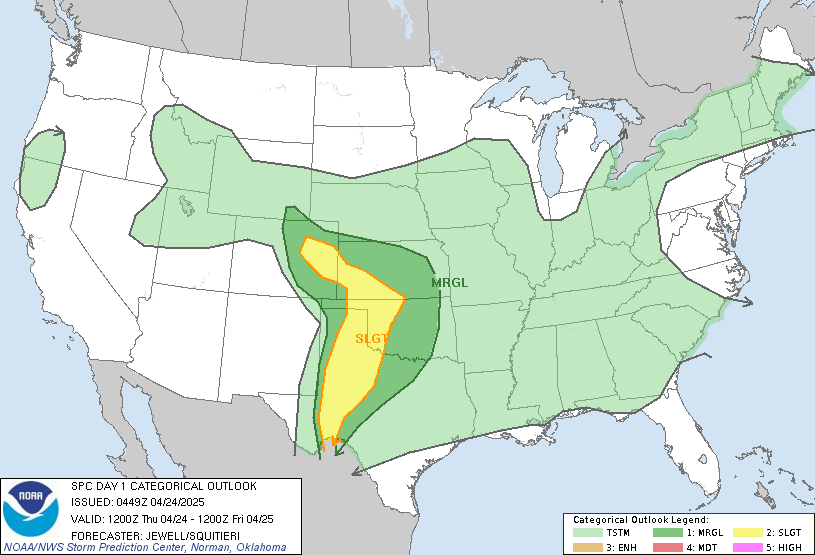LIVE MAP (ABOVE) ... SPC 1300Z Day 1 Outlook
Day 1 Convective Outlook
NWS Storm Prediction Center Norman OK
0643 AM CST Thu Feb 13 2025
Valid 131300Z - 141200Z
...THERE IS A MARGINAL RISK OF SEVERE THUNDERSTORMS FROM THE FLORIDA
PANHANDLE INTO SOUTHERN GEORGIA...AND OVER PARTS OF THE CENTRAL
VALLEY OF CALIFORNIA...
...SUMMARY...
Isolated, marginally severe storms are possible from the Florida
Panhandle into southern Georgia and parts of the Central Valley of
California. Damaging winds and a brief tornado are the primary
threats.
...Southeast...
Lead shortwave trough continues to progress through the OH Valley
this morning, and is expected to continue northeastward through the
Northeast today. Primary surface low associated with this system is
over the Lower Great Lakes, but a secondary triple point low exists
farther south over west-central GA. A cold front extends
southwestward from this secondary low off the AL coast while a warm
front extends eastward into the SC Lowcountry before arcing
northeastward along the SC and NC coasts. Warm sector between these
two features is characterized by temperatures in the upper 60s/low
70s and dewpoints in the 60s. A convective line is currently
traversing this warm sector, extending from the MMT vicinity in
central SC southwestward to off the FL Panhandle Coast east of ECP.
Modest buoyancy precedes this line across the central FL Panhandle
and southwest/south-central GA, but weakens with northern extent,
with MLCAPE dropping to less than 250 J/kg over southeast GA. In
contrast to this modest buoyancy, strong deep-layer shear extends
across the warm sector, which is contributing to modest updraft
organization within the line and occasional bowing segments. Shear
is expected to weaken throughout the day as the parent shortwave
trough becomes increasingly displaced north and the mid/low level
flow weakens. As a result, the severe potential over this region
today will likely be maximized from now through the next 4 to 6
hours while some overlap between the modest buoyancy and strong
shear exists. A few strong to severe storms are possible,
particularly where the line interacts with the warm front. Damaging
gusts will be the primary risk, but a brief line-embedded tornado is
possible as well.
...Central Valley of California...
Recent satellite imagery depicts an intense cyclone off the West
Coast, with a strong shortwave trough moving through its southern
periphery towards central CA. This shortwave is forecast to reach
the coast later this afternoon, with the ongoing warm-air advection
shower activity moving to the east/south as it does. As these
showers clear out, temperatures should warm into the upper 50s/low
60s while mid-level cold-air advection results in 500-mb
temperatures in the -22 to -25 deg C range. This will support weak
airmass destabilization, with modest buoyancy anticipated during the
afternoon. This could result in some deeper, more sustained
convection. Vertical shear will be strong enough to support
transient rotation within any deeper updrafts, yielding a localized
wind/brief tornado risk during the late afternoon.
..Mosier/Broyles.. 02/13/2025
Read more CHECK UPDATE ZOOM GRAPHIC
http://dlvr.it/THyGRc
Windy.com Temps | Gusts | WU KORD KPWK |
CLICK for this month's BIG night sky ... | RADAR FULL MAP SCREEN |
|---|
MOBILE DEVICE? Turn sideways. Weather conditions directly above are near Lakefront. Top tabs refer to O'Hare (official).
Archives for the SPC Convective Outlook are updated daily (approximately) with a live map at the beginning of each article. Follow the link at the end of the article to check for current updates on the NOAA/NWS Storm Prediction Center website. Also, see Archives for Chicago's hourly weather data on CARDINAL NEWS Magazine.
CONVECTIVE | TORNADO | WIND | HAIL
O'Hare International Airport KORD
(Arlington Heights South)
Chicago Executive Airport KPWK
(Arlington Heights North)
Thursday, February 13, 2025
SPC Feb 13, 2025 1300 UTC Day 1 Convective Outlook
SUNRISE AND SUNSET TIMES IN UTC (if you're not logged in to Google)
CHICAGO UTC-6 during CST (Central Standard Time, e.g., winter)
CHICAGO UTC-5 during CDT (Daylight Savings Time, e.g., summer)
CHICAGO UTC-6 during CST (Central Standard Time, e.g., winter)
CHICAGO UTC-5 during CDT (Daylight Savings Time, e.g., summer)





















